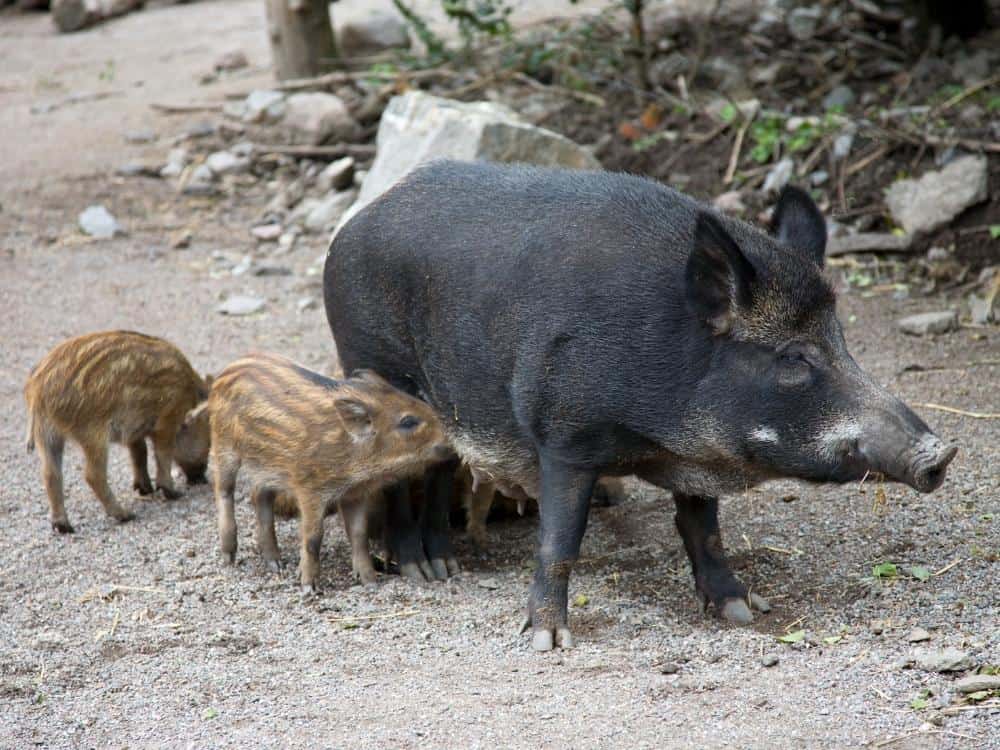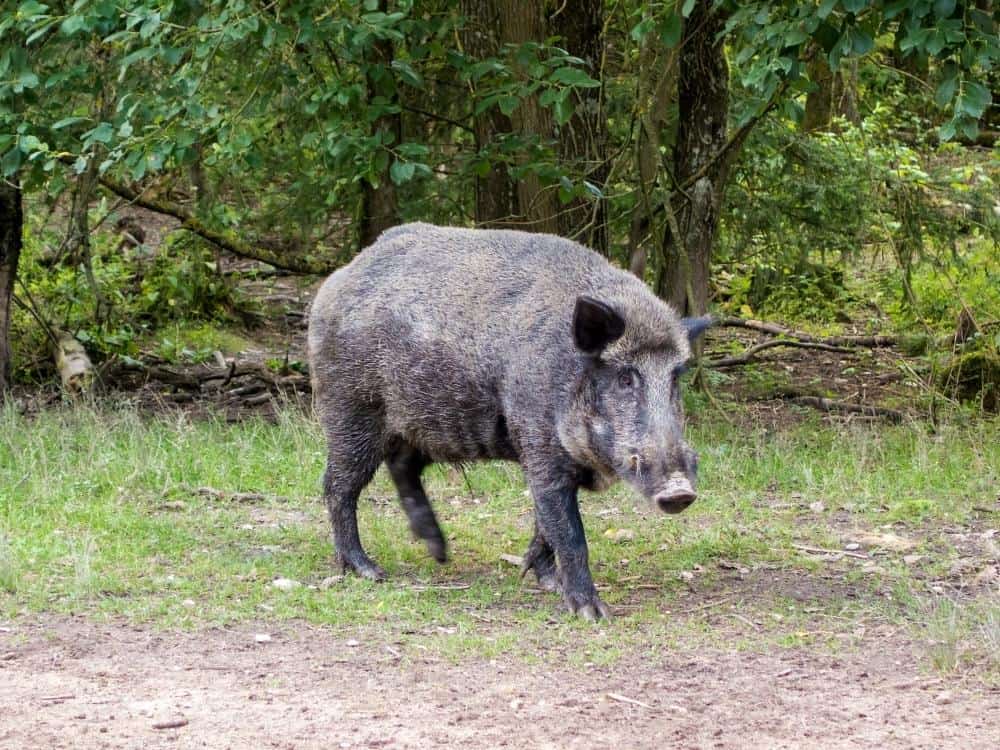Read In: 5 minutes
Wild Hogs, Boars, and Pigs are commonly seen in many parts of the United States but most frequently in Texas. They are a non-native, invasive species known to cause lots of problems on farms or other property.
Due to the species being invasive, damaging, and abundant, they are now being hunted and harvested for their meat. Many high-end restaurants and farmers are using these wild hogs to prepare their meals, and many have reported that it tastes better than regular pork.

Hog, Pig, or Boar?
Many different names around the US commonly refer to Wild Hogs, some of them being feral pigs, wild boars, etc. These terms are likely referring to the same species when used, and all these terms are correct in many cases.
A hog, boar, or pig are all different names for the same species, the Sus Scrofa; the terms are used to specify attributes of the animal.
- Pig: This refers to the domesticated Sus Scrofa, which most people refer to as a pig.
- Sow: Used to reference an adult female pig that has reached childbearing age.
- Swine: Vague term used to reference any subsets of the Sus Scrofa.
- Boar: Male Swine capable of mating and reproducing.
- Hog: Huge and usually older. Hogs can be male or female.
Wild or Feral?
Wild and feral are both applicable in many cases. After just one generation in the wild, feral hogs and wild hogs are almost indistinguishable from one another.
- Wild: Any animal that isn’t domesticated and lives in a natural environment.
- Feral: Escaped, domesticated animals that are now in the wild.
An escaped domestic animal in the wild is called feral for its entire life. Even if a feral animal reproduces, its offspring would still be considered feral due to the difference in genes between domesticated and non-domesticated animals.
Animals typically get referred to as wild after 2-3 generations in a natural environment due to changes in genes and behavior.

Hunting Wild Hogs
People have been hunting wild hogs for hundreds of years, as farmers in America dealt with wild hogs as early as the 1800s. However, it has become more common in recent years due to the damage that the species has caused, combined with their population getting out of control.
In Texas, anyone is legally allowed to hunt hogs without a license due to the abundance of wild hogs in rural areas, which has led to many different methods:
Spot and Stalk
This kind of hunting is the most common hog hunting seen in the US, as it refers to getting close enough to shoot once a hog is spotted. It is prevalent because hogs are usually seen when crossing roads which put them in sight of anyone in the area.
The tactic of stalking wild hogs is common due to their poor eyesight. Many commonly hunted animals, such as deer and elk, have excellent vision, allowing them to spot danger very far away. Unlike these other animals, hogs have extremely poor eyesight and aren’t good at identifying threats coming directly at them.
Still-Hunting
When thinking of normal hunting, this is most likely what’s pictured. On foot, the hunter slowly makes their way through a forest, looking for hogs in their habitat. Hogs have a great hearing to make up for their poor eyesight, which requires silence from hunters to succeed, hence the name still-hunting.
Hunting with Dogs
While most people don’t have dogs trained for this method, hunting with dogs is used by avid hunters due to the much higher success rate.
Trained dogs can sniff out the scent of wild hogs from extremely far away and are great at tracking them down. The dogs are trained to chase the hogs until they get one cornered, during which the dog will start barking to alert its owner.

Taking Down a Wild Hog
No matter which method you use for hunting wild hogs, it’s essential to know how to kill them properly. Hogs are incredibly tough animals and can be hard to take down swiftly for non-expert hunters. If hunted hogs are to be eaten, one must also field dress the hog once killed.
Taking Down a Wild Hog with a Gun
Many hunters use a rifle as their hunting weapon, as it’s the easiest method for quickly taking down individual animals. Whether one is still hunting, spotting and stalking, or using dogs, it doesn’t affect how to take out a hog. A few notes when hunting hogs with a gun:
- Always aim for their heart, located right behind their front shoulders. Vertically, a hog’s heart is placed lower than other animals. It’s about halfway up their body and even with the top of their front legs.
- Only shoot to kill. It is inhumane to leave wounded animals in the wild, and a wounded hog is a dangerous hog. Therefore, one must be confident that it will be a kill before firing.
Taking Down a Wild Hog with a Knife
If one can get close enough to use a knife, likely by using hunting dogs, it’s a relatively straightforward process. Any blade longer than three inches should be able to reach the heart with a thrust above the front legs. Most of a hog’s meat is on its neck and shoulders, so it’s best to avoid slicing through the edible meat.
Field Dressing a Wild Hog Once Killed
While hunters are familiar with field dressing, many people aren’t informed on the proper handling of a fresh kill.Three things need to be done within a couple of hours or else the meat will spoil:
- Gutting
- Skinning
- Cooling
Preparing and Eating Wild Hogs
Many people across the US have said that wild hog tastes better than normal pigs. While taste is subjective, some noticeable differences make it an excellent choice for restaurants and exotic meals.
- Rich Flavor: Rich, intense flavor that comes from their natural diet of nuts and berries, although the specific flavor can vary depending on what the wild hog was eating.
- Dark Meat: Tends to be darker and leaner, making it more nutritious than normal farm-raised pork. It provides all the same lean meat without any additives or extra fat.
- Unique: The distinct flavoring and odd name make it a popular choice for restaurants wanting to offer something special.
- Versatile: Like regular pork, you can use it in stews, sausage, lean meat, and so much more.
Sources:
- www.texas.gov/feral-hogs
- www.dartagnan.com/eating-wild-boar-meat
- www.mossyoak.com/what-you-need-to-know-about-cleaning-hogs
- www.hogwildok.com/pig-boar-or-hog-whats-the-difference
- www.smithsonianmag.com/a-plague-of-pigs-in-texas
Share me 🙂








